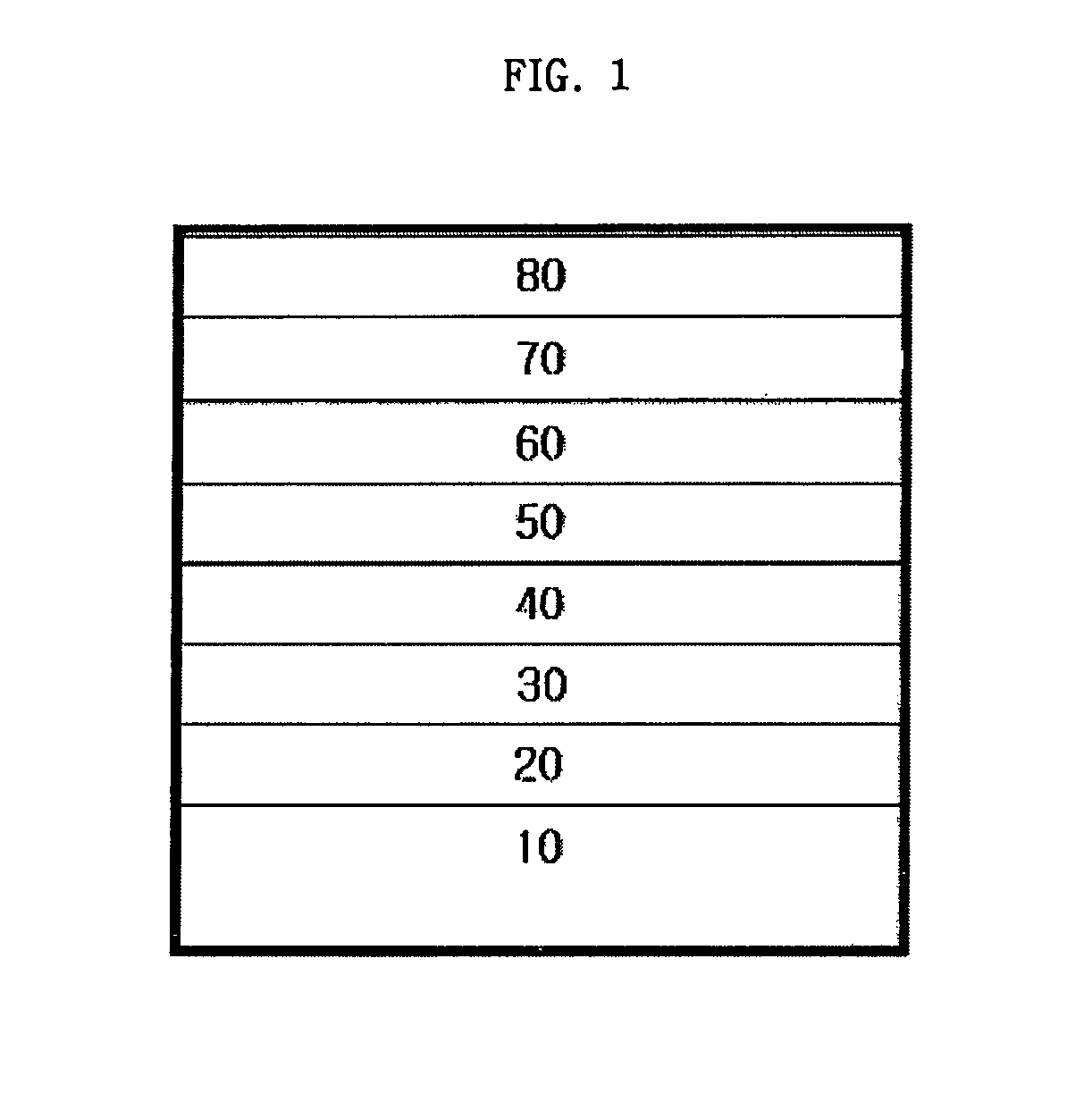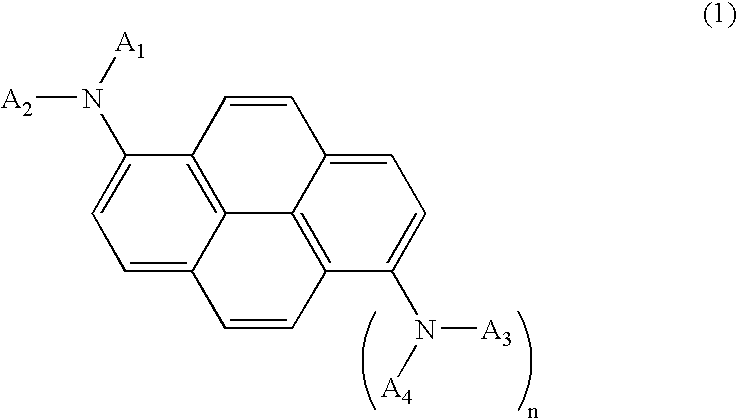Blue light emitting compound and organic electroluminescent device using the same
a technology of blue light and compound, which is applied in the direction of discharge tube luminescnet screen, other domestic articles, natural mineral layered products, etc., can solve the problems of limited viewing angle, limited application of organic light-emitting diodes, and inability to use backligh
- Summary
- Abstract
- Description
- Claims
- Application Information
AI Technical Summary
Benefits of technology
Problems solved by technology
Method used
Image
Examples
example 1
1(a): Synthesis of N-(4-cyanobenzo)-N′-(4-trimethylsilylbenzo)amine
[0053]4-Trimethylsilylbromobenzene (150 g, 0.65 moles) and 4-aminobenzonitrile (92.8 g, 0.79 moles) were dissolved in 2,500 ml of toluene in a three-neck round-bottom flask. To the solution were added palladium (II) acetate (5.9 g, 0.03 moles), 2,2′-bis(diphenylphosphino)-1,1′-binaphthyl (16.3 g, 0.03 moles) and sodium t-butoxide (94.4 g, 0.98 moles). The mixture was allowed to react for 48 hours while the temperature of the flask was raised to 85° C. After completion of the reaction, the hot reaction solution was filtered through a Buchner funnel containing a bed of celite. The filtrate was concentrated under reduced pressure at 50° C., and then the obtained concentrate was purified by column chromatography using hexane and ethyl acetate (4 / 1) as eluents. The developed solvents were completely removed to yield 56.9 g (0.21 moles, 32.6%) of the title product.
1(b): Synthesis of 1-[N-(4-cyanobenzo)-N′-(4-trimethylsilyl...
example 2
2(a): Synthesis of N-(4-triphenylsilylbenzo)-N′-(4-cyanobenzo)amine
[0057]4-Triphenylsilylbromobenzene (30 g, 0.072 moles) and 4-aminobenzonitrile (10.2 g, 0.086 moles) were dissolved in 600 ml of toluene in a three-neck round-bottom flask. To the solution were added palladium (II) acetate (0.65 g, 0.003 moles), 2,2′-bis(diphenylphosphino)-1,1′-binaphthyl (1.8 g, 0.003 moles) and sodium t-butoxide (13.88 g, 0.144 moles). The mixture was allowed to react for 48 hours while the temperature of the flask was raised to 90° C. After completion of the reaction, the hot reaction solution was filtered through a Buchner funnel containing a bed of celite. The filtrate was concentrated under reduced pressure at 50° C., and then the obtained concentrate was purified by column chromatography using hexane and ethyl acetate (4 / 1) as eluents. The developed solvents were completely removed to yield 19.6 g of (0.04 moles, 60%) of the title product as a solid.
2(b): Synthesis of 1-[N-(4-triphenylsilylben...
example 3
3(a): Synthesis of N-(3-cyanobenzo)-N′-(4-trimethylsilylbenzo)amine
[0061]4-Trimethylsilylbromobenzene (40 g, 0.17 moles) and 3-aminobenzonitrile (24.7 g, 0.21 moles) were dissolved in 800 ml of toluene in a three-neck round-bottom flask. To the solution were added palladium (II) acetate (0.8 g, 0.003 moles), 2,2′-bis(diphenylphosphino)-1,1′-binaphthyl (2.2 g, 0.003 moles) and sodium t-butoxide (33.5 g, 0.35 moles). The mixture was allowed to react for 80 hours while the temperature of the flask was raised to 90° C. After completion of the reaction, the hot reaction solution was filtered through a Buchner funnel containing a bed of celite. The filtrate was concentrated under reduced pressure at 50° C., and then the obtained concentrate was purified by column chromatography using hexane and ethyl acetate (4 / 1) as eluents. The developed solvents were completely removed to yield 15.4 g (0.06 moles, 33.1%) of the title product as a liquid.
3(b): Synthesis of 1,6-di[N-(3-cyanobenzo)-N′-(4-...
PUM
| Property | Measurement | Unit |
|---|---|---|
| temperature | aaaaa | aaaaa |
| temperature | aaaaa | aaaaa |
| pressure | aaaaa | aaaaa |
Abstract
Description
Claims
Application Information
 Login to View More
Login to View More - R&D
- Intellectual Property
- Life Sciences
- Materials
- Tech Scout
- Unparalleled Data Quality
- Higher Quality Content
- 60% Fewer Hallucinations
Browse by: Latest US Patents, China's latest patents, Technical Efficacy Thesaurus, Application Domain, Technology Topic, Popular Technical Reports.
© 2025 PatSnap. All rights reserved.Legal|Privacy policy|Modern Slavery Act Transparency Statement|Sitemap|About US| Contact US: help@patsnap.com



